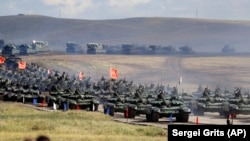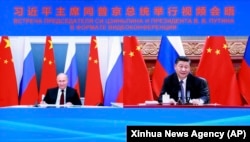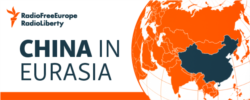
In the latest display of deepening ties between Beijing and Moscow, Chinese and Russian troops kicked off five days of military exercises in northwestern China on August 9.
More than 10,000 troops from the Chinese and Russian militaries are participating in the Zapad/Interaction 2021 drills in the Ningxia Hui Autonomous Region that will involve large numbers of aircraft, weapon systems, and vehicles.
The military exercises come as the security situation in Eurasia continues to shift, with the U.S.-led foreign military withdrawal from Afghanistan leading to increased fighting between the Taliban and government forces and shaking up the wider region.
This year's training marks the fourth consecutive exercises between Beijing and Moscow and the first joint drills held in China. The maneuvers will focus on stability in neighboring Central Asia as both countries look to showcase the growing cooperation between their militaries.
"This exercise is a natural progression of stronger military ties between the two countries, but the situation in Afghanistan adds an important new layer," Zhang Xin, an associate professor at the Center for Russian Studies at Shanghai's East China Normal University, told RFE/RL. "Both sides are worried about spillover into Central Asia and the new types of security challenges to the region that it could pose."
Chinese Defense Ministry spokesman Wu Qian said on August 5 that the goal was to "consolidate cooperation" and "maintain regional peace and security," focusing on counterterrorism and establishing a joint command center for better cooperation on joint reconnaissance, early warnings, joint strikes, and electronic and information attacks.
Driven together by shared antagonism toward the United States as well as similar strategic concerns for Central and South Asia, ties between China and Russia have grown increasingly close in recent years.
Both Beijing and Moscow have shown an increased willingness to tackle international issues together and the current military exercises focused on security in Central Asia and Afghanistan are the latest display of this evolving dynamic.
But according to Zhang, while military ties continue to expand and the countries find new ways to work together, China and Russia are not progressing toward "a military alliance in the traditional sense."
"This kind of exercise shows a move towards a closed but flexible collaboration between two militaries without entering into a full-scale alliance," Zhang said.
Beijing And Moscow's Evolving Ties
While the deteriorating security situation in Afghanistan continues to draw the attention of political and military leaders in China and Russia and presents opportunities for collaboration, ties between the two countries are expanding across several sectors.
Russia-China collaboration accelerated in 2014 following the Kremlin's seizure of Crimea, where Russia was placed in the crosshairs of Western sanctions.
Since then, Beijing and Moscow have seen their relationship grow closer, with expanded trade, high-tech cooperation, and growing political support for each other, especially during the COVID-19 pandemic. In June, both sides renewed the Sino-Russian Treaty of Good-Neighborliness and Friendly Cooperation as they celebrated its 20th anniversary.
Military ties have also been a focal point.
Chinese and Russian forces have been regularly doing drills together in some form -- bilaterally or through a multilateral organization -- since 2005, and those have expanded to also include joint naval exercises.
Starting in 2018, Beijing and Moscow expanded to larger-scale exercises, which emphasize training top-level commanders to work together and were marked that year by high-profile drills in Russia.
But despite the warming military and political ties, analysts say there are limits to the type of partnership that China and Russia are looking to forge with one another.
Alexander Gabuev, a senior fellow at the Moscow Carnegie Center, told RFE/RL that neither side wants to be locked into an alliance where they would be brought "into a fight where the other doesn't have skin in the game," pointing to disparities in China's positions toward Ukraine and Russia's toward Taiwan.
"They try to stay out of each other's fights and instead find those areas of overlap in mutual interest," he said. "China and Russia are very pragmatic and both oppose the United States, but both see themselves as great powers and are religious about their strategic autonomy."
A New Consensus
Following the current weeklong exercises, the Russian military and China's People's Liberation Army will also train together in September in drills organized under the banner of the Shanghai Cooperation Organization (SCO), a Eurasian security bloc helmed by Beijing and Moscow.
Like the maneuvers under way in China, the SCO drills will also have a counterterrorism focus.
The SCO -- which in addition to China and Russia consists of India, Kazakhstan, Kyrgyzstan, Pakistan, Tajikistan, and Uzbekistan -- has become a vehicle for Beijing's growing security ties across Eurasia, which are poised to grow against the backdrop of the U.S. troop withdrawal from Afghanistan.
Russia has traditionally seen the Central Asian countries of Kazakhstan, Kyrgyzstan, Tajikistan, Turkmenistan, and Uzbekistan as its own sphere of influence, but Beijing's rise as the dominant economic force has changed the dynamics in the region.
In recent years, China and Russia have looked to balance their interests in Central Asia between "Russian military muscle and China's wallet," Anton Barbashin, editorial director at the online journal Riddle Russia, told RFE/RL.
But he says this "consensus is no longer as solid as it was a decade ago" and that moving forward, the evolving situation in Afghanistan and its future effects on Central Asia will play a growing role in shaping China and Russia's future security cooperation in the region.
"We might be looking at the beginning of wider security cooperation over Afghanistan between China, Russia, and the Central Asian states," Barbashin said. "How this progresses will show if the SCO is a real organization capable of deterring the inevitable risks coming from Afghanistan or not."










